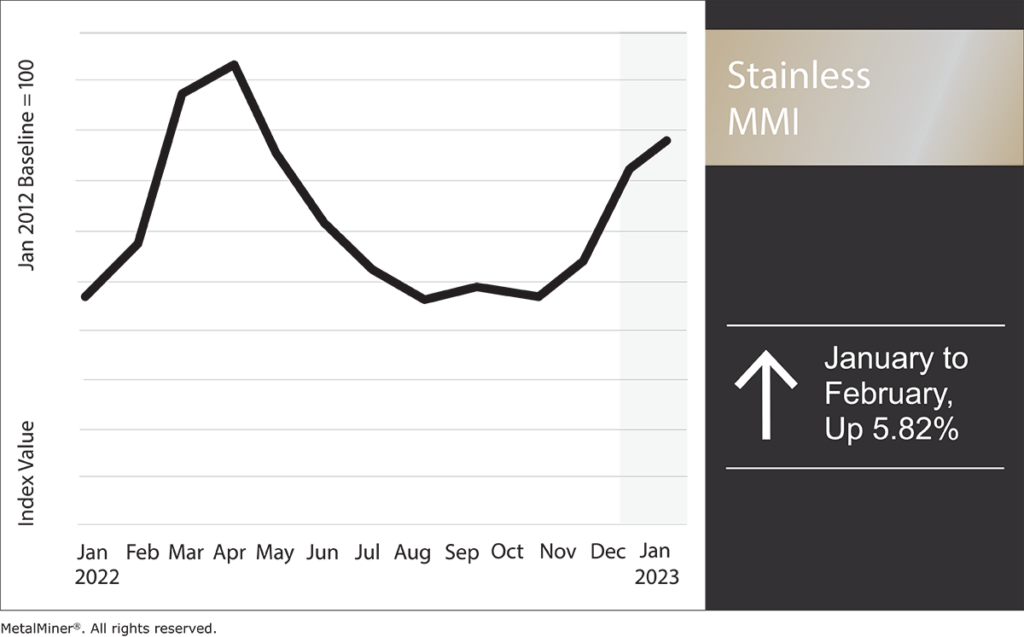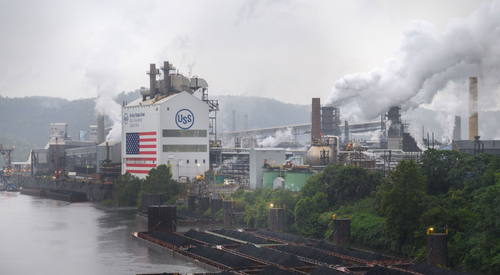Base Metals
Nickel Prices Return Sideways
The Stainless Monthly Metals Index (MMI) rose 5.82% from January to February as the nickel price index lost upward momentum. Nickel prices returned sideways…

The Stainless Monthly Metals Index (MMI) rose 5.82% from January to February as the nickel price index lost upward momentum.
Nickel prices returned sideways in the short term after finding a peak in January. Since the price has not bounced high enough to confirm an uptrend, downside risk may increase. Meanwhile, volume levels appear at least partially responsible for current stainless and nickel price action. Overall buyer volume has continued to decline since January. This comes after a much more substantial loss of liquidity in 2022. Now, the rally has not only lost momentum, but there is enough volatility in the market for nickel prices to have no clear market direction at all.
Make sure you are following the 5 best practices for sourcing stainless steel.

Stainless Inventories Still Elevated
Stainless inventories remain high for service centers, distributors, and end users. Some service centers reported having almost five months of supply on hand. For this reason, stainless buyers may still have a chance to make some opportunistic purchases.
On the other hand, import licenses into the U.S. for cold rolled stainless steel began to decline in July 2022. This was followed by a much steeper decline starting in October 2022. Of course, the U.S. cold rolled market needs some imports. After all, current U.S. flat-rolled production is not sufficient to supply demand. Fortunately, January 2023 import licenses increased to above 21,000 MT. Still, it remains possible that some items, such as light gauges or ferritics, may be in short supply by Q2. For the time being, recessionary concerns have somewhat apprehensive about placing forward orders.

Philippines Considers Nickel Export Tax or Ban Like Indonesia
Indonesia’s value-add strategy has begun to attract attention from other metal-rich nations. According to a recent report, the Philippines is the latest country to consider a raw nickel export tax or even an outright ban. Reports indicate the government is currently eyeing a 10% tax on nickel ore exports. Apparently, this is just one part of a larger plan to increase government revenue from the mining sector. The government of the Philippines is also reportedly mulling a 3% royalty payment on output from large-scale miners.
Like Indonesia, the Philippines aims to attract investments for downstream industries. According to Environment and Natural Resources Secretary Yulo Loyzaga, “we want to move out from being just part of the supply chain. We want to be part of the value chain.”
Get weekly updates on nickel price trends and other commodity news with MetalMiner’s free weekly newsletter. Click here.
Potential Impact on the Nickel Price and Global Market
In terms of market impact, a tax from the Philippines would add support to the nickel price, albeit to a lesser extent. It would also tighten nickel supply for the foreseeable future, thus increasing production costs for downstream industries. However, it is likely more of a medium- or long-term threat. Any such plans would require both approval and implementation before markets see any impact.
Moreover, should the Philippines attract the investments it seeks, it could take years for such industries to become operational. And should global economic pressures see demand for nickel drop, it could offset the potential impact. However, those pressures could also test the country’s resolve to continue the tax or ban. China would feel the brunt of the effects should the Philippines go forward with the policy, followed by Japan. China currently accounts for around 90% of the Philippines’ nickel exports.
See what else is impacting the nickel price and generate hard savings on your metal buys year-round. Try MetalMiner’s monthly outlook report.
Many Experts Remain Critical of the Plan
It is worth noting that such considerations have come with strong opposition, which could still derail the government’s plans. In fact, the largest critics of the move include the Philippines’ own mining sector. President of the Philippine Nickel Industry and Global Ferronickel Holdings Inc., Dante Bravo, recently told Reuters, “the initial proposal in the House of Representatives was 10%. That will kill the industry.”
Other critics have noted the flawed comparison between Indonesia and the Philippines. While Indonesia accounts for 48% of global supply, the Philippines accounts for just 11%. This gives Indonesia considerably more leverage in the market. According to the U.S. Geological Survey (USGS), the Philippines was the second largest producer in 2022. Still, its output sat markedly beneath that of Indonesia.
Estimates have Indonesia producing 1,600,000 tons of nickel in 2022. In the same year, the Philippines produced just 330,000 tons. Moreover, the ore supplied by the Philippines is reportedly lower quality than that sourced from Indonesia. The Philippines sits at an even greater disadvantage considering its reserves. While it remains the second largest global supplier, the Philippines holds only the 6th largest reserves. This fact alone could cause hesitation among potential investors.
MetalMiner can help your organization navigate nickel market volatility using AI technology. Read more here.

Beyond the Philippines: Nickel Price Concerns
A tax or outright ban from the Philippines is not, at this point, a guarantee. However, such considerations do pose an interesting hypothetical going forward. Will other countries follow? How about those that boast a larger market share? Chile and Peru, for example, stand as the world’s largest and second-largest copper producers, respectively. What’s more, both have repeatedly attempted to levy royalties on their mining industries over recent years.
Beyond that, estimates state that copper supply will experience a significant supply deficit in the coming years, partly due to growing demand. Projections like these could incentivize countries to adopt an Indonesian-style value-add strategy. This would prove especially tempting for those nations looking for ways to better exploit their resources. However, if this comes to fruition and other countries look to replicate Indonesia’s success, it will invariably reshape global market dynamics.
Check out MetalMiner’s stainless steel should cost models by scheduling a demo of the Insights platform.
Biggest Nickel and Stainless Steel Price Moves
- Chinese ferromolybdenum lump prices continued to surge, spiking 40.32% to $58,328 per metric ton as of February 1.
- Korean 430 cold rolled 2B coil prices rose 14.93% to $1,866 per metric ton.
- Chinese 316 cold rolled coil prices increased by 11.58% to $4,878 per metric ton.
- The Allegheny Ludlum Surcharge for 316/316L coil rose 11.14% to $2.35 per pound.
- Finally, LME primary three-month nickel price saw the only month-over-month decline of the overall index, with prices 4.06% to $29,670 per metric ton.

White House Prepares For “Serious Scrutiny” Of Nippon-US Steel Deal
White House Prepares For "Serious Scrutiny" Of Nippon-US Steel Deal
National Economic Adviser Lael Brainard published a statement Thursday…
How to Apply for FAFSA
Students and families will see a redesigned FAFSA this year. Here’s how to fill it out.
Dolly Varden consolidates Big Bulk copper-gold porphyry by acquiring southern-portion claims – Richard Mills
2023.12.22
Dolly Varden Silver’s (TSXV:DV, OTCQX:DOLLF) stock price shot up 16 cents for a gain of 20% Thursday, after announcing a consolidation of…














